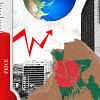GDP or Happiness?

Imagine a world where you earn a decent living, the state treats you with fairness, there is little carbon emission in the environment, and on top of everything else, the society values your opinion. Who wouldn't want to live in such a utopian world?
There is hardly any country in the world that takes into consideration all these indicators to determine whether the country and its people are happy. On the contrary, governments consider how fast the country is growing compared to the rest of the world. Bangladesh has achieved a GDP growth of 7.05 percent in the first quarter of 2016. This is an amazing achievement and we are expected to grow at an even faster rate in the coming days. The inclusion of Bangladesh in its Next 11 (N-11) list by Goldman Sachs supplements this expectation. These statistics sound very strong and gives the world a message about the emergence of a new economy - Bangladesh.
But when I ask myself how happy I am, I land in a dilemma - I am happy to earn a decent living, but pessimistic about other issues. Am I too unhappy? When I first met my former UNDP colleague Seeta Giri in 2010, she greeted me with a big smile. Later, I found her to be calmly dealing with tense and critical issues. One day I asked her about her secret to this serenity and she introduced me to Bhutan's unique concept of Gross National Happiness (GNH), established by King Jigme Singye Wangchuck in 1972. The country estimates its GNH based on sustainable development, preservation and promotion of cultural values, conservation of the natural environment and establishment of good governance. For more than three decades, this tiny nation has been nurturing GNH by preferring wellbeing over material growth, thereby attracting a lot of global interest in the face of decaying financial systems, disturbing inequity and wide-scale destruction of the environment. So far we have not been able to do justice to any of the pillars of happiness, which is rightly reflected in the World Happiness Report 2016 (WHR). Bangladesh secured the 110th position in this survey, with a score of 4.643 on a scale of 0-10, while Bhutan ranked the top (84) in South Asia, followed by Pakistan (92) and Nepal (107). Sri Lanka (117), India (118) and Afghanistan (154) fall behind us in this list.
Interestingly, there is a strong co-relation between sustainable development, governance and happiness. Eight out of the top ten developed countries, including Denmark, Switzerland, Norway, Finland, Canada, the Netherlands, New Zealand and Sweden ranked top positions in both the Corruption Perception Index (CPI) 2015 and the WHR 2016. This further indicates that countries with a high level of governance, less corruption and sustainable development are happier than countries that are found lacking in these areas. Our GDP 'speedometer' indicates that we are running fast. But the question remains whether we are running in the right direction.
Bangladesh should carefully determine whether its development efforts are sustainable and devised in a holistic, integrated approach to well-being. If we pursue individual objectives, such as economic development, and neglect the social and environmental objectives, we might face dire consequences in the future. Many countries in recent years have achieved economic growth at the cost of social exclusion, rising inequality and grave damage to the environment. China, which is presently facing an economic crisis, is perhaps the best example of this. In this backdrop, the UN has designed the Sustainable Development Goals (SDGs) to help countries adopt a more balanced approach, thereby leading to higher levels of well-being for the present and future generations, with a goal to end poverty, protect the planet, and ensure prosperity for all. The WHR 2016 states: "In particular the SDG Index helps to account for cross-national patterns of happiness even after controlling for GDP per capita and unemployment. A measure of Economic Freedom, as proposed by libertarians shows no such explanatory weight. The evidence suggests that indeed all three dimensions of sustainable development— economic, social, and environmental— are needed to account for the cross-country variation in happiness."
Since its inception by Bhutan, GNH has been gaining momentum every year. In 2010, the United Kingdom introduced the Measuring National Wellbeing Programme in an attempt to measure the level of satisfaction of British citizens at an individual, community and national level. In July 2011, the UN General Assembly unanimously adopted Resolution 65/309 that placed "happiness" on the global development agenda for the first time. The same year, the Organization for Economic Co-operation and Development (OECD) launched its "Better Life Index" (BLI). 2012 marked several development projects inspired by GNH - South Korea and the city of Seattle (Washington, USA) launched their respective happiness index, while the government of Goa (India) initiated a strategy for socioeconomic development. All of them cited the GNH Index as a model for measuring happiness. In 2014, the government of Dubai launched a localised happiness index to measure the level of satisfaction of public services.
Should Bangladesh try something similar, in parallel with the existing economic indicators? It may not be the best idea to replace GDP or GNI with a happiness index, but Bangladesh should strive to find some answers - how happy are Bangladeshis as individuals, as a community and, above all, as a nation. How sustainable are the development figures for the future? In addition to counting economic indicators, taking into consideration an existence of good governance backed by effective anti-corruption drives, a job market which offers decent work environment for all, equal treatment of individuals and conservation of nature could take the country to a whole new level of development and happiness.
The writer is a communication-for-development professional. He can be reached at [email protected]

 For all latest news, follow The Daily Star's Google News channel.
For all latest news, follow The Daily Star's Google News channel. 








Comments